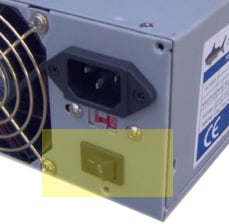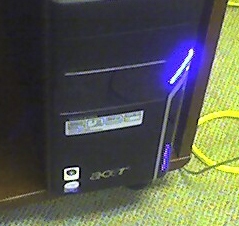Help! My Computer Won't Boot!
Let's Start with the Basics.
It may seem silly, but there are some very basic things to check before we carry on further. Each of these items will have fixes later on in this article.
- Is the power cord plugged in?
- Is the surge protector or power bar turned on?
- Is there a light on the front of the tower?
- Is there a light on the monitor?
Example of Where to find Power Supply

Is the power cord plugged in?
To find out, make sure you can see the back of your computer. This is where all the wires appear to be coming out. One of those wires is quite a bit thicker than all the others, and generally black in colour. It often sits in it's own plug away from all the other cables, and there is a fan beside it. Give this cable a firm push to be sure it hasn't come loose.
Follow this cable now by sliding your hands along it's length, until you get to where it draws it's power from. Ideally this should be a surge protector, but sometimes it is a simple power bar or worse, going directly into the wall outlet. Once you know where it is going, check to be sure it didn't get pulled out of it's power outlet. Push it firmly into place to be sure it hasn't come loose.
Occasionally, the capacitors in the power supply will need draining and simply won't provide power to the unit. To see if this is the case, look for the rocker switch on the power supply in a position similar to that highlighted in the picture to the right here. Unplug the power cable, move the rocker switch to off for a few hours, turn it back on, plug the power cable back in and press the computer's power button again.
Further Discussion
- Review and Discussion of Surge Protectors as Opposed to Power Bars or Power Strips
What's the difference between power bars and surge protectors? They look the same! Do they? Learn some of the key differences and where you can buy them.
Is the surge protector or power bar turned on?
While we are checking the power source for the computer's cable, let's check to see if that power source is actually on. Power bars and surge protectors have little power lights to indicate if the unit is on or off.
If the unit is off, look for the power switch and turn it back on. If the power switch is on, but no power light, check that the surge protector or power bar's cable is properly plugged into the wall.
If the unit is properly plugged in but getting no power, check the breaker box at your location to be sure a breaker isn't blown in the building. If all the breakers are good, but the power bar/surge protector will not grab power, it may be that it's own fuse has blown and time to replace the unit with a working one.
Some surge protectors have a reset switch to reset the breaker in the unit itself. Set that switch to see if the unit will now receive power from the wall. If not, time to replace the unit with a working one.
Power Button on Computer


How to Replace your Power Supply
Is there a light on the front of the tower?
By this time in our troubleshooting process, we've made sure your computer is plugged in, and that it is capable of getting power from the power source. Now it's time to check the unit itself.
This time I want you to look at the front of your computer. Most computers have a few lights on the front indicating various things from power to harddrive activity to wireless, etc.
Do you see a light on the front of your computer? If so, it is very likely the computer is already on. Place your ear to the machine to hear if fans are running or not. If the light is on, you will more than likely hear fans and/or activity inside the case.
If the light on the front of the computer is off however, there could be bigger issues here.
Push the power button and keep an ear to the computer case. You should hear a series of beeps and then hear fans and other activity as the computer begins to boot up. If you hear beeps but nothing is happening and the light comes on, there are hardware issues that need to be addressed.
If you hear nothing and the light does NOT come on, the power supply may need replacing on your computer. Time to call a reputable computer repair technician and get the power supply replaced. Occasionally the power supply is fine, but the power button is broken. Get a certified tech to look over the situation and get you back up and running.
But if you saw a light on the computer, and you heard fan activity inside the computer, it's time for the next step.
Example of a Monitor Power Button

Example of Replacing a Video Card
Is there a light on the monitor?
This may seem really dumb to the average user, but believe it or not, I was called to a client's home who claimed their PC was no longer turning on for them. When I got there, I saw the monitor's light off and just instinctively turned it on before reaching for the computer's power button. To my surprise, the computer was already running! The client had a speaker in front of the monitor button, and when the speaker was pushed up against that button, the monitor turned off, causing the client to think their computer was no longer booting. They felt so silly calling me out for that.
So now it's time to check and make sure the monitor's power light is on. Some monitors have the power light go orange when the computer is in sleep mode or off. The power light is usually green a connection to the computer is detected.
If you don't see a power light, press the power button and wait a few seconds to see if the monitor is getting a signal from the computer. If the computer screen comes up on the monitor, you're good to go. However if the monitor displays an error that it can't find a connection, then you know that A) the monitor is fine, and B) the connection to or from the computer is not fine.
If the latter, time to check the monitor's power cable the way we checked the computer's cable earlier. Once you know that cable is plugged in tight on the back of the monitor and tight into it's outlet on the working surge protector or powerbar, it's time to check the data cable.
The data cable may have a blue, black, or white end on it, depending on whether it is a VGA, DVI, or HDMI cable. It will sit on the back of the monitor as well and can sometimes work itself loose. Make sure it is plugged in tight on the back of the monitor and then follow the cable with your hands to where it plugs into the back of your computer. Make sure it's connection to the back of the computer is also tight and try the power button on the monitor again.
If the screen displays fine, you're good to go. If the computer booted fine but there is nothing displaying on your computer even after the above two checks, it's time to test that monitor on a different computer, and time to test a different monitor on your existing computer.
If the original monitor won't work on another computer, it's died on you and time to get another monitor.
If the different monitor now attached to your existing computer won't work either, then the video card on your computer may have died and time to replace the video card. There are youtube videos out there showing you how to do this. However if you don't feel up to the task, get a reputable certified computer tech to replace the video card for you.
More Suggestions
Below are two places where you can find information or parts to assist if the above steps revealed deeper issues that need to be fixed.
Parts on Amazon
Fun Poll
Have you ever replaced parts on your PC before?
© 2013 Marilynn Dawson









